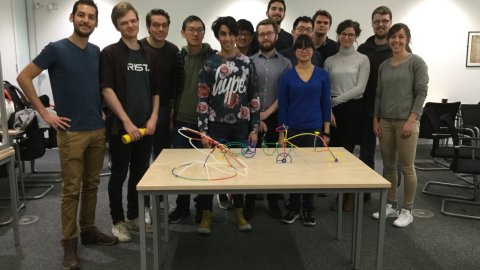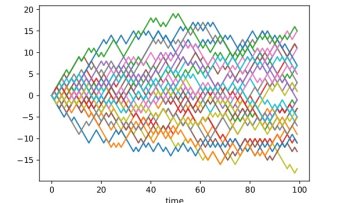The role of polyconvexity in dynamical problems of thermomechanics
Abstract
The stabilization of thermo-mechanical systems is a classical problem in thermodynamics and well
understood in a context of gases. The objective of this talk is to indicate the role of null-Lagrangians and
certain transport/stretching identities in stabilizing thermomechanical systems associated with general
thermoelastic free energies. This allows to prove various convergence results among thermomechan-
ical theories, and suggests a variational scheme for the approximation of the equations of adiabatic
thermoelasticity.
11:00
The Kronecker-Weber theorem
Abstract
The Kronecker-Weber theorem states that every finite abelian extension of the rationals is contained in some cyclotomic field. I will present a proof that emphasizes the standard local-global philosophy by first proving it for the p-adics and then deducing the global case.
Weak universality for the KPZ equation (and also others)
Abstract
Many singular stochastic PDEs are expected to be universal objects that govern a wide range of microscopic models in different universality classes. Two notable examples are KPZ and \Phi^4_3. In these cases, one usually finds a parameter in the system, and tunes according to the space-time scale in such a way that the system rescales to the SPDE in the large-scale limit. We justify this belief for a large class of continuous microscopic growth models (for KPZ) and phase co-existence models (for Phi^4_3), allowing microscopic nonlinear mechanisms far beyond polynomials. Aside from the framework of regularity structures, the main new ingredient is a moment bound for general nonlinear functionals of Gaussians. This essentially allows one to reduce the problem of a general function to that of a polynomial. Based on a joint work with Martin Hairer, and another joint work in progress with Chenjie Fan and Jiawei Li.
A Model-Based Derivative-Free Approach to Black-Box Adversarial Examples in Deep Learning
Abstract
Neural Network algorithms have achieved unprecedented performance in image recognition over the past decade. However, their application in real world use-cases, such as self driving cars, raises the question of whether it is safe to rely on them.
We generally associate the robustness of these algorithms with how easy it is to generate an adversarial example: a tiny perturbation of an image which leads it to be misclassified by the Neural Net (which classifies the original image correctly). Neural Nets are strongly susceptible to such adversarial examples, but when the architecture of the target neural net is unknown to the attacker it becomes more difficult to generate these examples efficiently.
In this Black-Box setting, we frame the generation of an adversarial example as an optimisation problem solvable via derivative free optimisation methods. Thus, we introduce an algorithm based on the BOBYQA model-based method and compare this to the current state of the art algorithm.
16:00
The spectrum of simplicial volume
Abstract
Simplicial volume was first introduced by Gromov to study the minimal volume of manifolds. Since then it has emerged as an active research field with a wide range of applications.
I will give an introduction to simplicial volume and describe a recent result with Clara Löh (University of Regensburg), showing that the set of simplicial volumes in higher dimensions is dense in $R^+$.
16:00
Finite quotients of surface groups
Abstract
It is often fruitful to study an infinite discrete group via its finite quotients. For this reason, conditions that guarantee many finite quotients can be useful. One such notion is residual finiteness.
A group is residually finite if for any non-identity element g there is a homomorphism onto a finite group, which doesn’t map g to e. I will mention how this relates to topology, present an argument why the surface groups are residually finite and I’ll show that in this case it is enough to consider homomorphisms onto alternating groups.
Robust Identification of Drones and UAVs in the Air Space for Improving Public Safety and Security
Abstract
The disruptive drone activity at airports requires an early warning system and Aveillant make a radar system that can do the job. The main problem is telling the difference between birds and drones where there may be one or two drones and 10s or 100s of birds. There is plenty of data including time series for how the targets move and the aim is to improve the discrimination capability of tracker using machine learning.
Specifically, the challenge is to understand whether there can be sufficient separability between birds and drones based on different features, such as flight profiles, length of the track, their states, and their dominance/correlation in the overall discrimination. Along with conventional machine learning techniques, the challenge is to consider how different techniques, such as deep neural networks, may perform in the discrimination task.
Oxford Mathematician Harald Oberhauser talks about some of his recent research that combines insights from stochastic analysis with machine learning:



